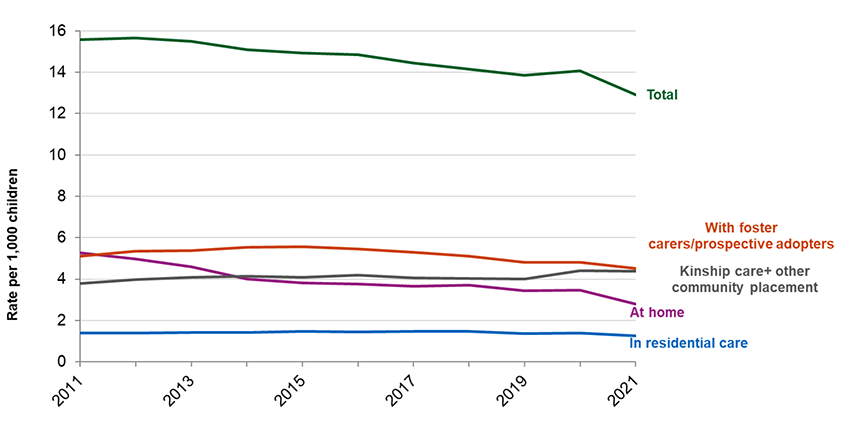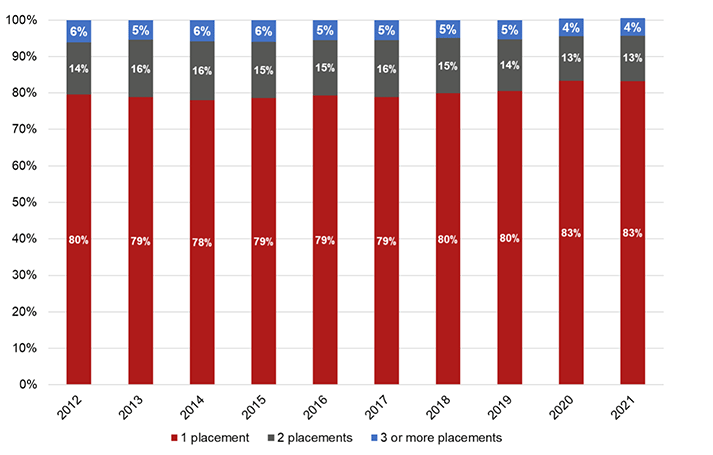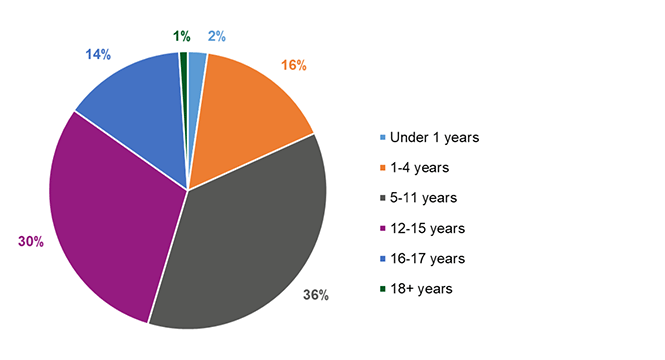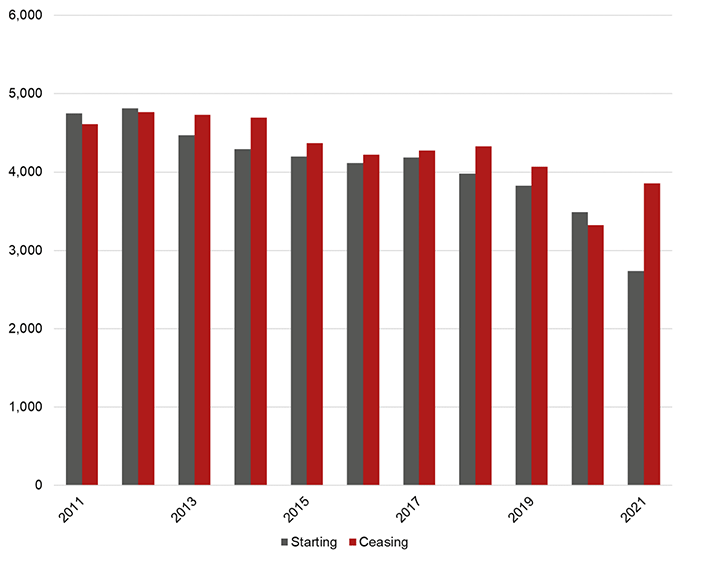National Care Service - children's social services: overview
Overview of social services provided to children and families in Scotland. It forms one of a collection of contextual papers about social care and related areas in Scotland, linking to the National Care Service consultation.
This document is part of a collection
Looked after children
Under the Children (Scotland) Act 1995, looked after children are those in the care of their local authority. Children can be looked after and live at home if they are subject to a CSO. Where children and young people are looked after away from home, this can be where the child:
- has been through the Children's Hearings system and is subject to a CSO with a condition of residence;
- is subject to an order made or authorisation or warrant granted by virtue of chapter 2, 3 or 4 of Part 2 of the 1995 Act;
- is being provided with accommodation under Section 25 of the 1995 Act (a voluntary agreement);
- is placed by a local authority which has made a permanence order under section 80 of the Adoption and Children (Scotland) Act 2007.
There are many reasons children may become looked after, including:
- they face abuse or neglect at home;
- they have disabilities that require special care;
- they are unaccompanied minors seeking asylum, or who have been illegally trafficked into the UK;
- they have been involved in the youth justice system.
Children may be looked after for a short time, longer time, or it could be episodic – there are a range of different circumstances. Children who are looked after away from home may be placed with kinship carers (extended family/friends), foster carers, with prospective adopters, or in residential care (see next section on types of placements).
As at 31 July 2021, 13,255 children were looked after, reflecting 1.3% of Scotland's child population[15] and the lowest this figure has been since 2006. Of these, 95% had a current care plan[16] produced by the local authority.
Over the past decade, the number of looked after children in Scotland has declined (Chart 7), peaking in 2012 and was at its lowest in 2021.

5.1 Types of placements
At home with parents: A child becomes looked after at home when the Children's Hearing imposes a supervision requirement with no condition of residence. There are two main instances in which this happens:
- as a starting point for planned intervention, where the balance of risk indicates that it is not essential to remove the child from the care of their parents, but that the situation must be monitored;
- where children are returning home after being looked after away from home, where some risks still remain and home supervision aims to help reunite the family.
A child looked after at home continues to live at their usual residence (usually the family home), but receives regular visits from social workers to ensure that the objectives of the home supervision order are being met. In 2021, 2,859 children were placed at home with parents (22% of all looked after children).
Kinship care: when a child is looked after by their extended family or close friends if they cannot remain with their birth parents. Under the Looked after children (Scotland) Regulations 2009, a kinship carer is defined as: "a person who is related to the child (through blood, marriage or civil partnership) or a person with whom the child has a pre-existing relationship". In 2021, 4,399 children were placed in kinship care (33% of all looked after children).
Foster care: when a child is looked after by an approved foster family in their home. Fostering can be provided for short breaks or to provide interim, long term or permanent care for children. In 2021, 3,160 children were placed with foster carers provided by a local authority and 1,307 children were placed with foster carers purchased by a local authority (24% and 10% of all looked after children, respectively). In 2020, there were 59 fostering services in Scotland, with 27 independent services in addition to 32 local authority services and a total of 3,540 approved foster care households.
Prospective adopters: when a child is placed with their prospective adopters. In 2021, 156 children were placed with prospective adopters (1% of all looked after children).
Residential child care: Residential care homes provide accommodation, support and, in some cases, education for young people, usually of secondary school age. In 2021, 1,286 children were placed in a residential placement (10% of all looked after children). In 2020, residential child care provision included 323 care homes for children, 5 secure care centres, and 37 residential special schools.
In 2021, most looked after children (90%) were placed in the community (Table 3). Notably, while the proportion of children placed at home with parents decreased over the past decade (from 34% in 2011 to 22% in 2021), the proportion of children placed with kinship carers increased (from 24% in 2011 to 33% in 2021).
| Number | Percentage | |||
|---|---|---|---|---|
| 2011 | 2021 | 2011 | 2021 | |
| In the community | 14,770 | 11,969 | 91% | 90% |
| At home with parents | 5,476 | 2,859 | 34% | 22% |
| With Kinship Carers: friends/relatives | 3,910 | 4,399 | 24% | 33% |
| With Foster Carers provided by LA | 3,871 | 3,160 | 24% | 24% |
| With Foster Carers purchased by LA | 1,197 | 1,307 | 7% | 10% |
| With prospective adopters | 267 | 156 | 2% | 1% |
| In other community | 49 | 88 | 0% | 1% |
| In residential accommodation | 1,461 | 1,286 | 9% | 10% |
| In local authority home | 615 | 525 | 4% | 4% |
| In voluntary home | 88 | 96 | 1% | 1% |
| In residential special school | 460 | 323 | 3% | 2% |
| In secure accommodation | 86 | 38 | 1% | 0% |
| Crisis care | 13 | 0 | 0% | 0% |
| In other residential | 199 | 304 | 1% | 2% |
| Total | 16,231 | 13,255 | 100% | 100% |
The bulk of the 'other residential' placements are private/independent residential placements for young people with complex needs.
Due to rounding, the percentage totals may not equal the sum of their parts.
In terms of the number of placements provided for children who are looked after, the pattern has remained relatively stable since 2012 (Chart 8). Notably, since 2012 the proportion of children with 3 or more placements has decreased slightly from 6% to 4% in 2021. By contrast, the proportion of children with a single placement has increased from 80% in 2012 to 83% in 2021.

5.1.1 Demographic profile of looked after children
In 2021, 54% of looked after children were male and 46% were female. The highest proportions were aged 5-11 years (36%) and 12-15 years (30%; Chart 9).

In 2021, the majority (84%) of looked after children were white (Table 3).
| Ethnic Group | Number | Percentage | % all children in Scotland (2011 Census) |
|---|---|---|---|
| White | 11,141 | 84% | 95% |
| Mixed Ethnicity | 171 | 1% | 1% |
| Asian, Asian Scottish or Asian British | 122 | 1% | 3% |
| Black, Black Scottish or Black British | 92 | 1% | 1% |
| Other Ethnic Background | 198 | 1% | 0% |
| Not known | 1,531 | 12% | 0% |
| Total | 13,255 | 100% | 100% |
Scotland percentages refer to ages 0 to 19 and are based on the 2011 census.
In 2021, 10% of looked after children had a disability, though disability status was not known/recorded for a quarter of children (Table 5).
| Disability | Number | Percentage |
|---|---|---|
| Yes | 1,288 | 10% |
| No | 8,589 | 65% |
| Not yet assessed | 92 | 1% |
| Not known/recorded | 3,286 | 25% |
| Total | 13,255 | 100% |
This is defined as having a mental or physical impairment which has a substantial and long-term adverse effect on their ability to carry out normal day-to-day activities.
Due to rounding, the percentage totals may not equal the sum of their parts.
5.2 Social services support for looked after children
When children and young people are looked after, social services will provide support in various ways and carry out a number of functions. This includes:
- Supporting children and families who voluntarily reach accommodation agreements and support the family to keep the child safe and nurtured in a placement out with the usual family home.
- Recruitment and assessment of prospective foster carers and adopters; and the identification and assessment of potential kinship carers for children who require care away from home. The conversion rate from initial enquiry to approval and registration as a foster carer is one in twelve. Thereafter supporting children, carers and/or parents, even following a permanency decision, to prevent breakdown of family relationships and further supporting the child or young person to maintain sibling type relationships where appropriate.
- Supporting children and young people to maintain meaningful relationships with the people that they identify as important to them. This may include tracing 'lost' family relationships and facilitating family meetings. Additionally, helping children and young people, even following their experience of care, to find and connect with key people and supporting their understanding of their life story.
5.3 Children ceasing to be looked after
In 2021, substantially more children ceased to be looked after, than started to become looked after. By contrast, in 2011 slightly more children started to become looked after than ceased (Chart 10).

Compared with 2011, a higher proportion of children ceasing to be looked after had been looked after for five years or longer – up from 13% in 2011 to 21% in 2021. Meanwhile the proportion of children looked after for a shorter period of time, especially for between 6 months and under 1 year, decreased (from 16% in 2011 to 10% 2021).
In terms of the recorded destinations of children ceasing to be looked after in 2021 (Table 6):
- 56% had a recorded destination of at home with their biological parents – a 4 percentage point decrease since 2011 (60%);
- 16% had a recorded destination of kinship care – a 3 percentage point increase since 2011 (13%);
- 6% of children were adopted – a figure which has remained stable since 2011. The majority of children who were adopted (66%) were below the age of 5 years.
| Destination after leaving care | Number | Percentage | ||
|---|---|---|---|---|
| 2011 | 2021 | 2011 | 2021 | |
| Home with (biological) parents | 2,766 | 2,166 | 60% | 56% |
| Kinship carers: Friends/relatives | 603 | 532 | 13% | 14% |
| Kinship Care Order | - | 84 | - | 2% |
| Former foster carers | 55 | 47 | 1% | 1% |
| Continuing Care | - | 267 | - | 7% |
| Adoption | 264 | 224 | 6% | 6% |
| Supported accommodation/own tenancy | 285 | 244 | 6% | 6% |
| Other | 225 | 276 | 5% | 7% |
| Not known | 413 | 16 | 9% | 0% |
| Total | 4,611 | 3,856 | 100% | 100% |
This excludes planned series of short term placements. A child may cease to be looked after more than once during the year and will be counted once for each episode of care ending.
New destination categories of 'Continuing Care' and 'Kinship Care Order' were added in 2018. Previously, children who left care for 'Continuing Care' were mostly recorded in the 'Foster Carers' destination category, while those whole left care under a 'Kinship Care Order' were mostly recorded in the 'Kinship Carers (friends/relatives)' category.
'Other' includes residential care, homeless, in custody and other destination.
Due to rounding, the percentage totals may not equal the sum of their parts.
5.4 Support for care leavers
5.4.1 Pathway planning
It is expected that all young people who are looked after on their 16th birthday will have had a pathway assessment, and will have a pathway plan in place as to their future before they cease to be looked after. This will set out the actions that must be taken by the local authority, the young person, their parents, their carers, and other agencies to enable them to achieve their aspirations and make a successful transition to adulthood. In 2021, 71% of eligible young people had a pathway plan. Further, 56% of eligible young people had a pathway co-ordinator (Table 7).
| Number | Percentage | |||
|---|---|---|---|---|
| 2016 | 2021 | 2016 | 2021 | |
| With pathway plan | 838 | 994 | 65% | 71% |
| Without pathway plan | 445 | 411 | 35% | 29% |
| With pathway co-ordinator | 923 | 788 | 72% | 56% |
| Without pathway co-ordinator | 360 | 617 | 28% | 44% |
| Total | 1,283 | 1,405 | 100% | 100% |
Figures include all episodes of ceasing to be looked after beyond 16 years of age (i.e. a young person may be counted more than once).
It may be the case that some young people who don't have a relevant pathway plan/coordinator may be receiving similar support from adult services instead.
5.4.2 Continuing care
Young people aged 16 years or over who are looked after in foster, kinship, or residential care are eligible to remain in their current care placement until the age of 21 – also known as Continuing Care[17]. In 2021, 534 young people were in Continuing Care.
5.4.3 Aftercare
Aftercare services[18] refer to local authorities' duty to provide advice, guidance, and assistance for all care leavers who cease to be looked after on or after their 16th birthday, and are below 26 years of age. This provision applies to all care leavers regardless of the placement type while looked after. Social services provide this support for young people who have experienced care and who are moving on to independence. In 2021, 54% of young people eligible for aftercare support were in receipt of aftercare services (Table 8).
| Number | Percentage | |||
|---|---|---|---|---|
| 2016 | 2021 | 2016 | 2021 | |
| In receipt of aftercare | 3,054 | 3,931 | 66% | 54% |
| Not in receipt of aftercare | 1,548 | 3,392 | 34% | 46% |
| Total | 4,602 | 7,323 | 100% | 100% |
5.4.4 Demographic profiles of young people receiving aftercare services
Of the eligible young people receiving aftercare services, 55% were male and 45% were female. The highest proportion of eligible young people in receipt of aftercare services were those aged 19-21 years (58%; Table 9). The lowest proportion of children in receipt of aftercare services were those aged 16 years (46%).
| Status | 16 | 17 | 18 | 19-21 | 22+ | Total |
|---|---|---|---|---|---|---|
| In receipt of aftercare | 118 | 311 | 619 | 1,584 | 1,299 | 3,931 |
| Not in receipt of aftercare | 136 | 264 | 544 | 1,150 | 1,298 | 3,392 |
| Total eligible for aftercare | 254 | 575 | 1,163 | 2,734 | 2,597 | 7,323 |
| In receipt of aftercare | 46% | 54% | 53% | 58% | 50% | 54% |
| Not in receipt of aftercare | 54% | 46% | 47% | 42% | 50% | 46% |
| Total eligible for aftercare | 100% | 100% | 100% | 100% | 100% | 100% |
Age on 31 July 2021.
Contact
For queries relating to a child at risk of harm please contact the appropriate local authority directly.
For queries relating to this publication contact: childrens.statistics@gov.scot
There is a problem
Thanks for your feedback